engine BMW M3 CONVERTIBLE 2002 E46 Service Manual
[x] Cancel search | Manufacturer: BMW, Model Year: 2002, Model line: M3 CONVERTIBLE, Model: BMW M3 CONVERTIBLE 2002 E46Pages: 159, PDF Size: 2.19 MB
Page 136 of 159
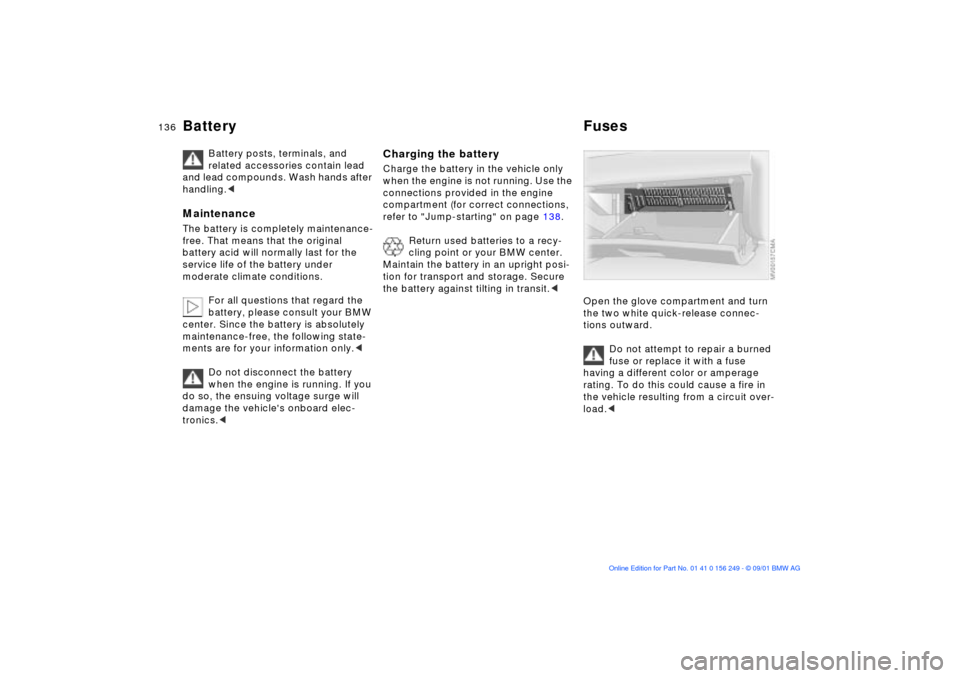
136n
Battery Fuses
Battery posts, terminals, and
related accessories contain lead
and lead compounds. Wash hands after
handling.<
Maintenance The battery is completely maintenance-
free. That means that the original
battery acid will normally last for the
service life of the battery under
moderate climate conditions.
For all questions that regard the
battery, please consult your BMW
center. Since the battery is absolutely
maintenance-free, the following state-
ments are for your information only.<
Do not disconnect the battery
when the engine is running. If you
do so, the ensuing voltage surge will
damage the vehicle's onboard elec-
tronics.<
Charging the battery Charge the battery in the vehicle only
when the engine is not running. Use the
connections provided in the engine
compartment (for correct connections,
refer to "Jump-starting" on page 138.
Return used batteries to a recy-
cling point or your BMW center.
Maintain the battery in an upright posi-
tion for transport and storage. Secure
the battery against tilting in transit.<
Open the glove compartment and turn
the two white quick-release connec-
tions outward.
Do not attempt to repair a burned
fuse or replace it with a fuse
having a different color or amperage
rating. To do this could cause a fire in
the vehicle resulting from a circuit over-
load.<
Page 137 of 159
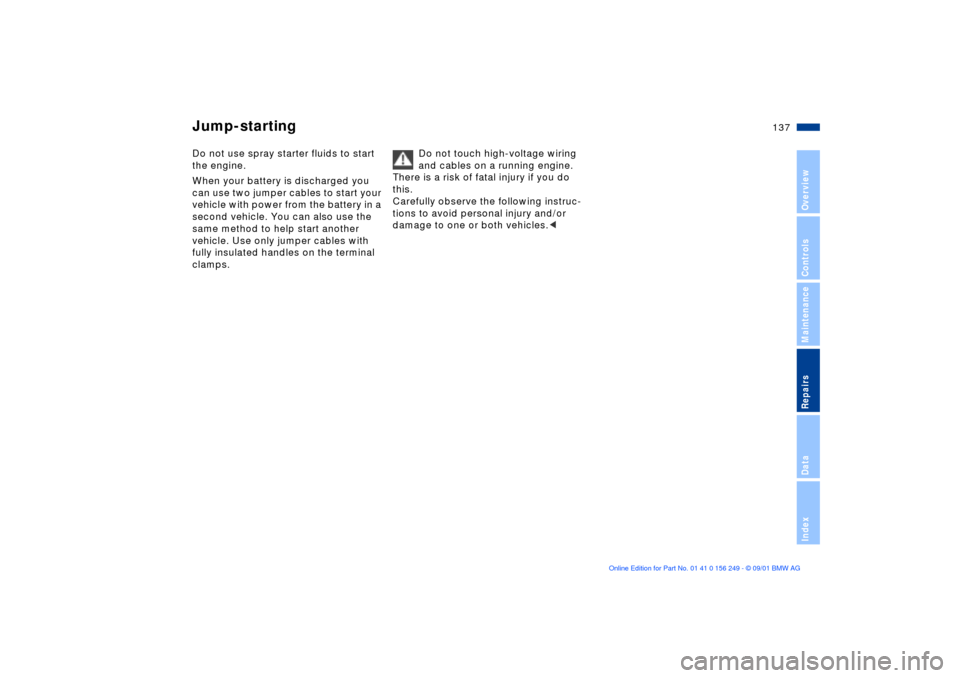
137n
OverviewControlsMaintenanceRepairsDataIndex
Do not use spray starter fluids to start
the engine.
When your battery is discharged you
can use two jumper cables to start your
vehicle with power from the battery in a
second vehicle. You can also use the
same method to help start another
vehicle. Use only jumper cables with
fully insulated handles on the terminal
clamps. Do not touch high-voltage wiring
and cables on a running engine.
There is a risk of fatal injury if you do
this.
Carefully observe the following instruc-
tions to avoid personal injury and/or
damage to one or both vehicles.< Jump-starting
Page 138 of 159
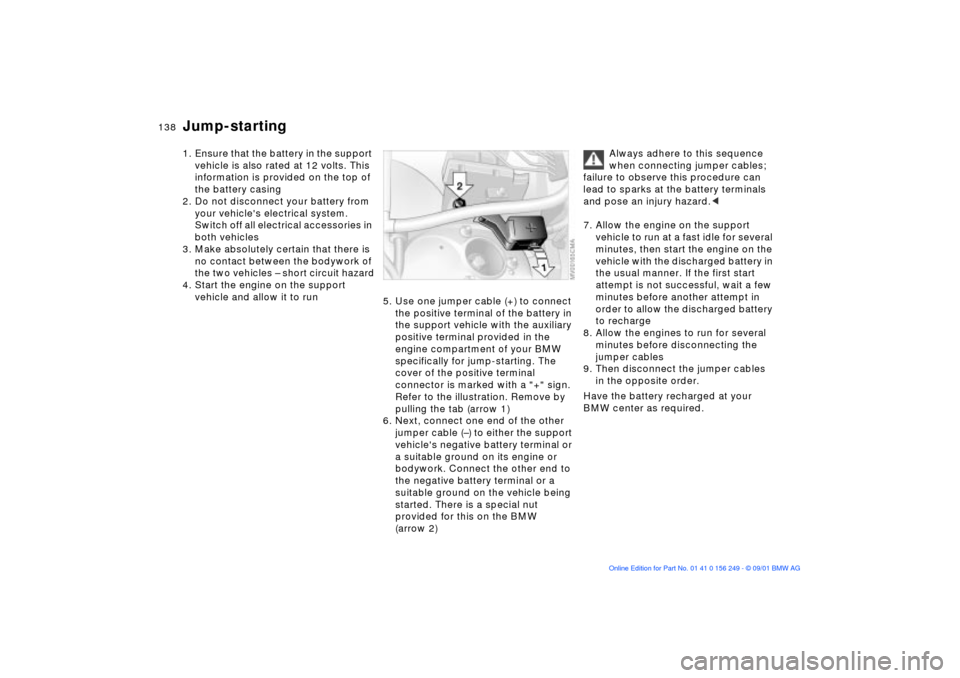
138n
Jump-starting1. Ensure that the battery in the support
vehicle is also rated at 12 volts. This
information is provided on the top of
the battery casing
2. Do not disconnect your battery from
your vehicle's electrical system.
Switch off all electrical accessories in
both vehicles
3. Make absolutely certain that there is
no contact between the bodywork of
the two vehicles Ð short circuit hazard
4. Start the engine on the support
vehicle and allow it to run
5. Use one jumper cable (+) to connect
the positive terminal of the battery in
the support vehicle with the auxiliary
positive terminal provided in the
engine compartment of your BMW
specifically for jump-starting. The
cover of the positive terminal
connector is marked with a "+" sign.
Refer to the illustration. Remove by
pulling the tab (arrow 1)
6. Next, connect one end of the other
jumper cable (Ð) to either the support
vehicle's negative battery terminal or
a suitable ground on its engine or
bodywork. Connect the other end to
the negative battery terminal or a
suitable ground on the vehicle being
started. There is a special nut
provided for this on the BMW
(arrow 2)
Always adhere to this sequence
when connecting jumper cables;
failure to observe this procedure can
lead to sparks at the battery terminals
and pose an injury hazard.<
7. Allow the engine on the support
vehicle to run at a fast idle for several
minutes, then start the engine on the
vehicle with the discharged battery in
the usual manner. If the first start
attempt is not successful, wait a few
minutes before another attempt in
order to allow the discharged battery
to recharge
8. Allow the engines to run for several
minutes before disconnecting the
jumper cables
9. Then disconnect the jumper cables
in the opposite order.
Have the battery recharged at your
BMW center as required.
Page 140 of 159

140n
Towing the vehicleUse only a nylon towing strap to tow
the vehicle, since the inherent resil-
ience of this material helps protect both
vehicles from sudden jerking move-
ments.
The towed vehicle should always
be the lighter of the two vehicles.
If this is not the case, it will not be
possible to control vehicle handling.
Never attempt to use your vehicle to
push another vehicle, since damage to
the energy-absorbing bumpers could
result.
Towing a vehicle1. Gearshift lever in neutral
2. Towing speed:
Max. 45 mph (70 km/h)
3. Towing distance:
Max. 95 miles (150 km)
4. Leave the ignition key at position 1 to
ensure that the brake lamps, turn
signal indicators, horn and wind-
shield wipers remain operative, and
to prevent the steering lock detent
from engaging
5. Switch on the hazard warning system
(observe applicable legal regula-
tions).
Find some means of identifying the
vehicle in tow, for instance, place a sign
or warning triangle in the rear window.
Make sure that the ignition key
remains in position 1 even when
the electrical system has failed to
prevent the steering lock from
engaging.
The steering and brakes are without
power-assist when the engine is off.
This means that increased effort is
required for steering and braking.c
Vehicles with sequential M gearbox
*
SMG II:
To push or tow, engage selector lever
in position 0.
Never work on the vehicle with a
driving position engaged.c
Page 144 of 159
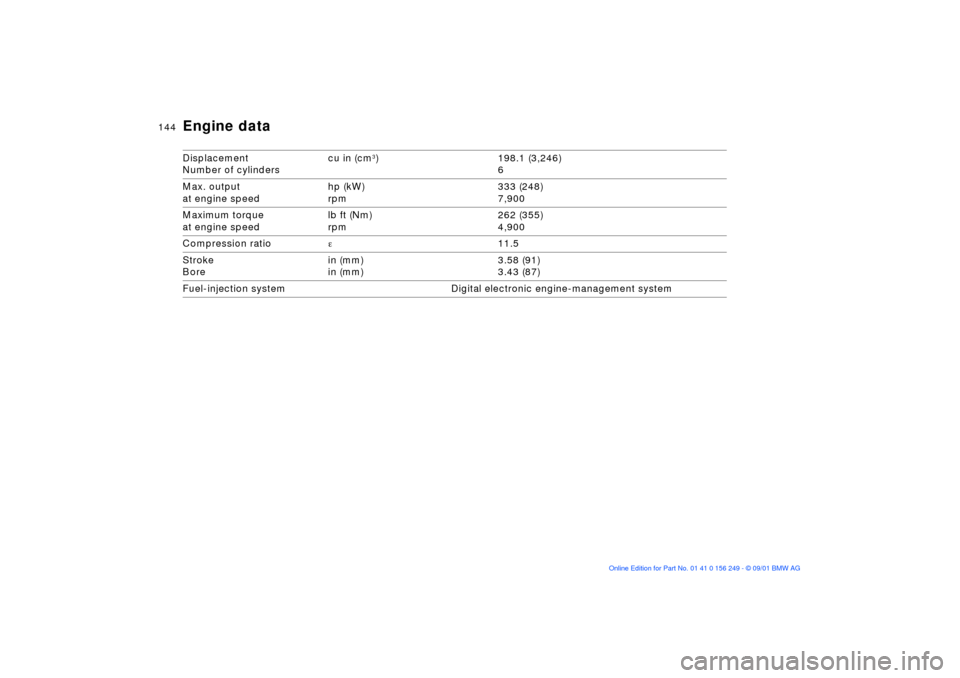
144n
Displacement
Number of cylinders cu in (cm
3) 198.1 (3,246)
6
Max. output
at engine speed hp (kW)
rpm333 (248)
7,900
Maximum torque
at engine speedlb ft (Nm)
rpm262 (355)
4,900
Compression ratioe
11.5
Stroke
Borein (mm)
in (mm)3.58 (91)
3.43 (87)
Fuel-injection system Digital electronic engine-management system
Engine data
Page 147 of 159
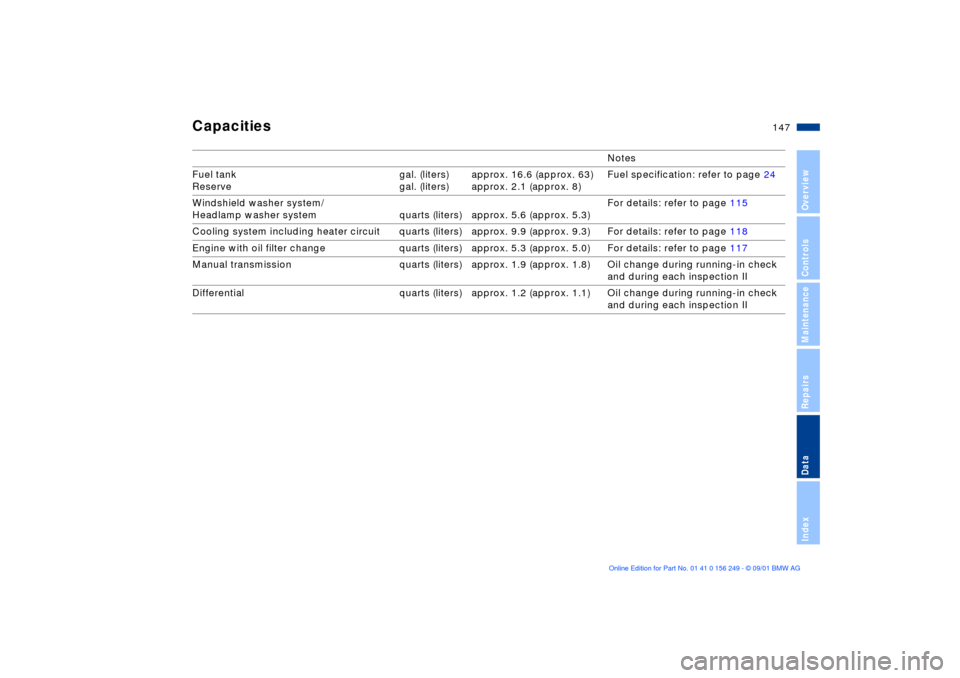
147n
OverviewControlsMaintenanceRepairsDataIndex
Capacities
Notes
Fuel tank
Reserve gal. (liters)
gal. (liters)approx. 16.6 (approx. 63)
approx. 2.1 (approx. 8)Fuel specification: refer to page 24
Windshield washer system/
Headlamp washer system quarts (liters) approx. 5.6 (approx. 5.3)For details: refer to page 115
Cooling system including heater circuit quarts (liters) approx. 9.9 (approx. 9.3) For details: refer to page 118
Engine with oil filter change quarts (liters) approx. 5.3 (approx. 5.0) For details: refer to page 117
Manual transmission quarts (liters) approx. 1.9 (approx. 1.8) Oil change during running-in check
and during each inspection II
Differential quarts (liters) approx. 1.2 (approx. 1.1) Oil change during running-in check
and during each inspection II
Page 150 of 159
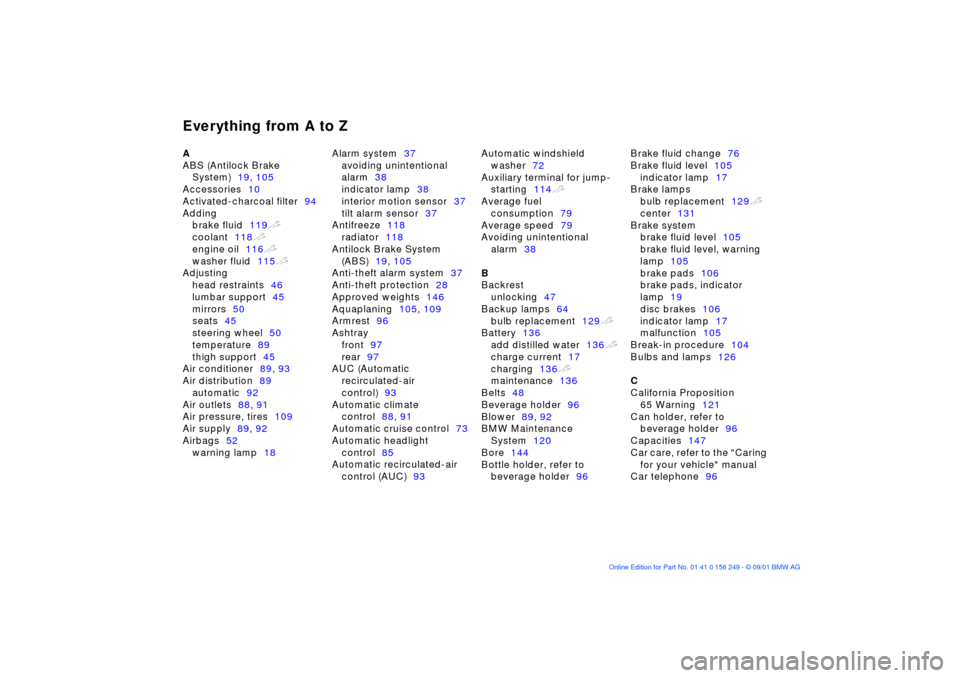
Everything from A to Z
A
ABS (Antilock Brake System) 19, 105
Accessories 10
Activated-charcoal filter 94
Adding brake fluid 119t
coolant 118t
engine oil 116t
washer fluid 115t
Adjusting head restraints 46
lumbar support 45
mirrors 50
seats 45
steering wheel 50
temperature 89
thigh support 45
Air conditioner 89, 93
Air distribution 89
automatic 92
Air outlets 88, 91
Air pressure, tires 109
Air supply 89, 92
Airbags 52
warning lamp 18 Alarm system
37
avoiding unintentional
alarm 38
indicator lamp 38
interior motion sensor 37
tilt alarm sensor 37
Antifreeze 118
radiator 118
Antilock Brake System (ABS) 19, 105
Anti-theft alarm system 37
Anti-theft protection 28
Approved weights 146
Aquaplaning 105, 109
Armrest 96
Ashtray front 97
rear 97
AUC (Automatic recirculated-air
control) 93
Automatic climate control 88, 91
Automatic cruise control 73
Automatic headlight
control 85
Automatic recirculated-air control (AUC) 93 Automatic windshield
washer 72
Auxiliary terminal for jump- starting 114t
Average fuel consumption 79
Average speed 79
Avoiding unintentional alarm 38
B
Backrest unlocking 47
Backup lamps 64
bulb replacement 129t
Battery 136
add distilled water 136t
charge current 17
charging 136t
maintenance 136
Belts 48
Beverage holder 96
Blower 89, 92
BMW Maintenance System 120
Bore 144
Bottle holder, refer to beverage holder 96 Brake fluid change
76
Brake fluid level 105
indicator lamp 17
Brake lamps bulb replacement 129t
center 131
Brake system brake fluid level 105
brake fluid level, warning
lamp 105
brake pads 106
brake pads, indicator
lamp 19
disc brakes 106
indicator lamp 17
malfunction 105
Break-in procedure 104
Bulbs and lamps 126
C
California Proposition 65 Warning 121
Can holder, refer to beverage holder 96
Capacities 147
Car care, refer to the "Caring
for your vehicle" manual
Car telephone 96
Page 151 of 159
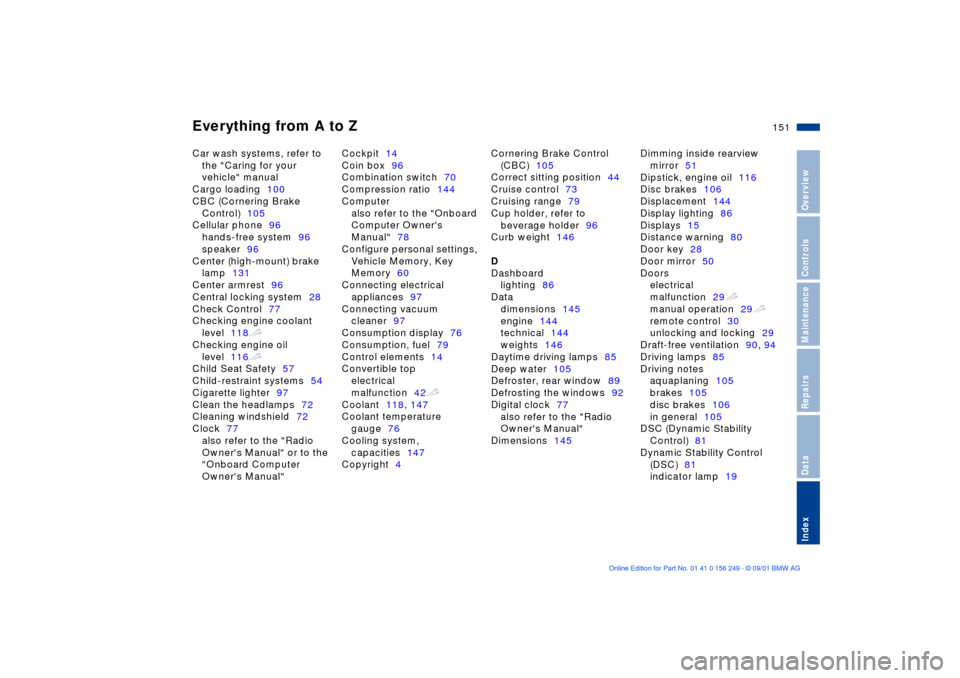
Everything from A to Z
151n
OverviewControlsMaintenanceRepairsDataIndex
Car wash systems, refer to
the "Caring for your
vehicle" manual
Cargo loading100
CBC (Cornering Brake
Control)105
Cellular phone96
hands-free system96
speaker96
Center (high-mount) brake
lamp131
Center armrest96
Central locking system28
Check Control77
Checking engine coolant
level118t
Checking engine oil
level116t
Child Seat Safety57
Child-restraint systems54
Cigarette lighter97
Clean the headlamps72
Cleaning windshield72
Clock77
also refer to the "Radio
Owner's Manual" or to the
"Onboard Computer
Owner's Manual" Cockpit14
Coin box96
Combination switch70
Compression ratio144
Computer
also refer to the "Onboard
Computer Owner's
Manual"78
Configure personal settings,
Vehicle Memory, Key
Memory60
Connecting electrical
appliances97
Connecting vacuum
cleaner97
Consumption display76
Consumption, fuel79
Control elements14
Convertible top
electrical
malfunction42t
Coolant118, 147
Coolant temperature
gauge76
Cooling system,
capacities147
Copyright4 Cornering Brake Control
(CBC)105
Correct sitting position44
Cruise control73
Cruising range79
Cup holder, refer to
beverage holder96
Curb weight146
D
Dashboard
lighting86
Data
dimensions145
engine144
technical144
weights146
Daytime driving lamps85
Deep water105
Defroster, rear window89
Defrosting the windows92
Digital clock77
also refer to the "Radio
Owner's Manual"
Dimensions145 Dimming inside rearview
mirror51
Dipstick, engine oil116
Disc brakes106
Displacement144
Display lighting86
Displays15
Distance warning80
Door key28
Door mirror50
Doors
electrical
malfunction29t
manual operation29t
remote control30
unlocking and locking29
Draft-free ventilation90, 94
Driving lamps85
Driving notes
aquaplaning105
brakes105
disc brakes106
in general105
DSC (Dynamic Stability
Control)81
Dynamic Stability Control
(DSC)81
indicator lamp19
Page 152 of 159
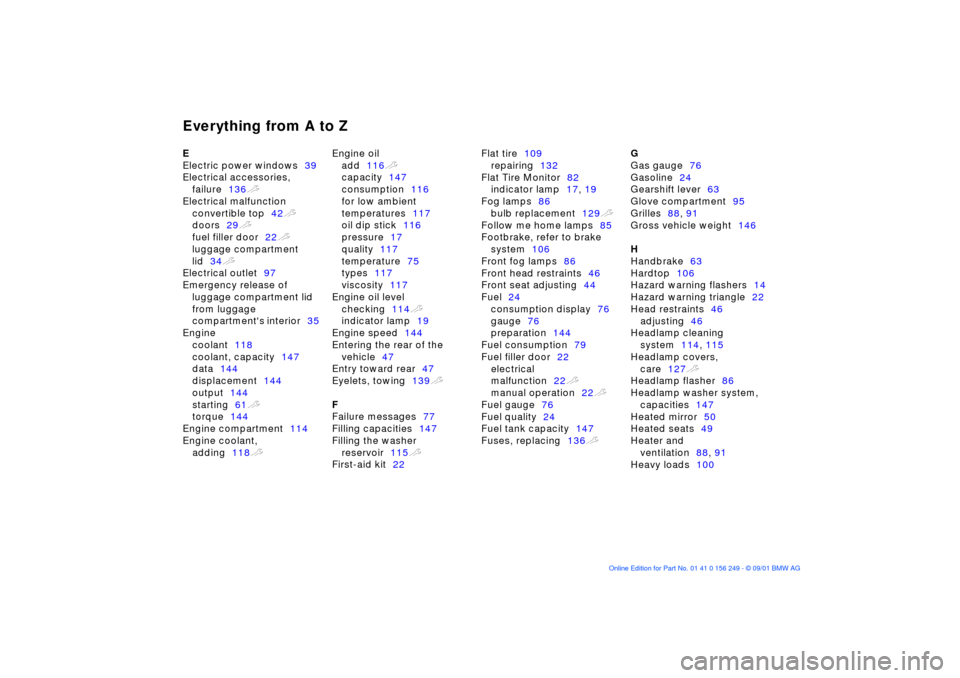
Everything from A to ZE
Electric power windows39
Electrical accessories,
failure136t
Electrical malfunction
convertible top42t
doors29t
fuel filler door22t
luggage compartment
lid34t
Electrical outlet97
Emergency release of
luggage compartment lid
from luggage
compartment's interior35
Engine
coolant118
coolant, capacity147
data144
displacement144
output144
starting61t
torque144
Engine compartment114
Engine coolant,
adding118t Engine oil
add116t
capacity147
consumption116
for low ambient
temperatures117
oil dip stick116
pressure17
quality117
temperature75
types117
viscosity117
Engine oil level
checking114t
indicator lamp19
Engine speed144
Entering the rear of the
vehicle47
Entry toward rear47
Eyelets, towing139t
F
Failure messages77
Filling capacities147
Filling the washer
reservoir115t
First-aid kit22 Flat tire109
repairing132
Flat Tire Monitor82
indicator lamp17, 19
Fog lamps86
bulb replacement129t
Follow me home lamps85
Footbrake, refer to brake
system106
Front fog lamps86
Front head restraints46
Front seat adjusting44
Fuel24
consumption display76
gauge76
preparation144
Fuel consumption79
Fuel filler door22
electrical
malfunction22t
manual operation22t
Fuel gauge76
Fuel quality24
Fuel tank capacity147
Fuses, replacing136t G
Gas gauge76
Gasoline24
Gearshift lever63
Glove compartment95
Grilles88, 91
Gross vehicle weight146
H
Handbrake63
Hardtop106
Hazard warning flashers14
Hazard warning triangle22
Head restraints46
adjusting46
Headlamp cleaning
system114, 115
Headlamp covers,
care127t
Headlamp flasher86
Headlamp washer system,
capacities147
Heated mirror50
Heated seats49
Heater and
ventilation88, 91
Heavy loads100
Page 154 of 159
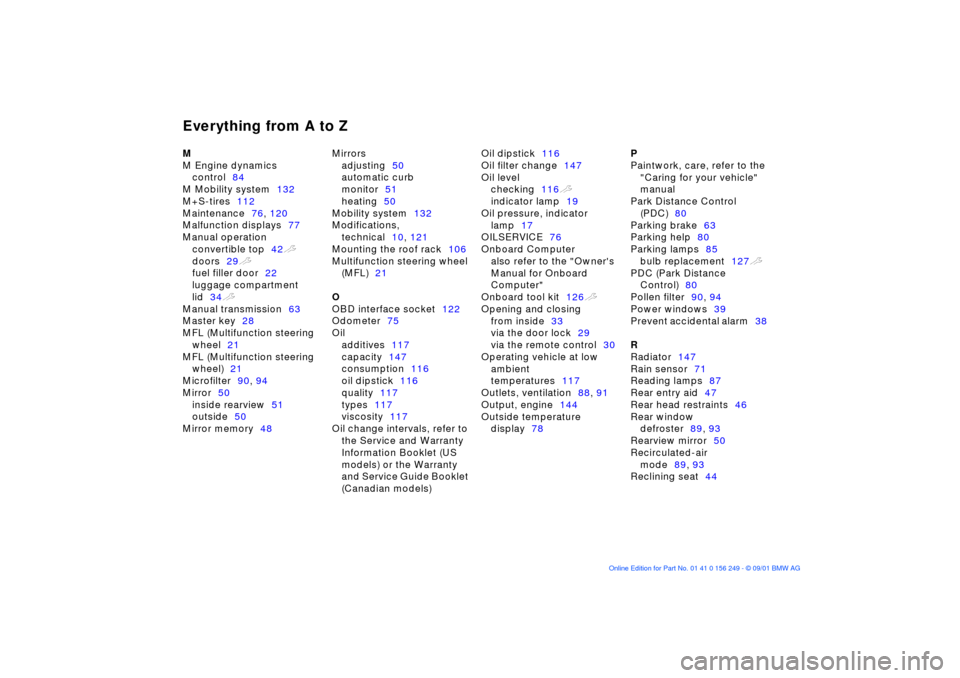
Everything from A to ZM
M Engine dynamics
control84
M Mobility system132
M+S-tires112
Maintenance76, 120
Malfunction displays77
Manual operation
convertible top42t
doors29t
fuel filler door22
luggage compartment
lid34t
Manual transmission63
Master key28
MFL (Multifunction steering
wheel21
MFL (Multifunction steering
wheel)21
Microfilter90, 94
Mirror50
inside rearview51
outside50
Mirror memory48 Mirrors
adjusting50
automatic curb
monitor51
heating50
Mobility system132
Modifications,
technical10, 121
Mounting the roof rack106
Multifunction steering wheel
(MFL)21
O
OBD interface socket122
Odometer75
Oil
additives117
capacity147
consumption116
oil dipstick116
quality117
types117
viscosity117
Oil change intervals, refer to
the Service and Warranty
Information Booklet (US
models) or the Warranty
and Service Guide Booklet
(Canadian models) Oil dipstick116
Oil filter change147
Oil level
checking116t
indicator lamp19
Oil pressure, indicator
lamp17
OILSERVICE76
Onboard Computer
also refer to the "Owner's
Manual for Onboard
Computer"
Onboard tool kit126t
Opening and closing
from inside33
via the door lock29
via the remote control30
Operating vehicle at low
ambient
temperatures117
Outlets, ventilation88, 91
Output, engine144
Outside temperature
display78 P
Paintwork, care, refer to the
"Caring for your vehicle"
manual
Park Distance Control
(PDC)80
Parking brake63
Parking help80
Parking lamps85
bulb replacement127t
PDC (Park Distance
Control)80
Pollen filter90, 94
Power windows39
Prevent accidental alarm38
R
Radiator147
Rain sensor71
Reading lamps87
Rear entry aid47
Rear head restraints46
Rear window
defroster89, 93
Rearview mirror50
Recirculated-air
mode89, 93
Reclining seat44